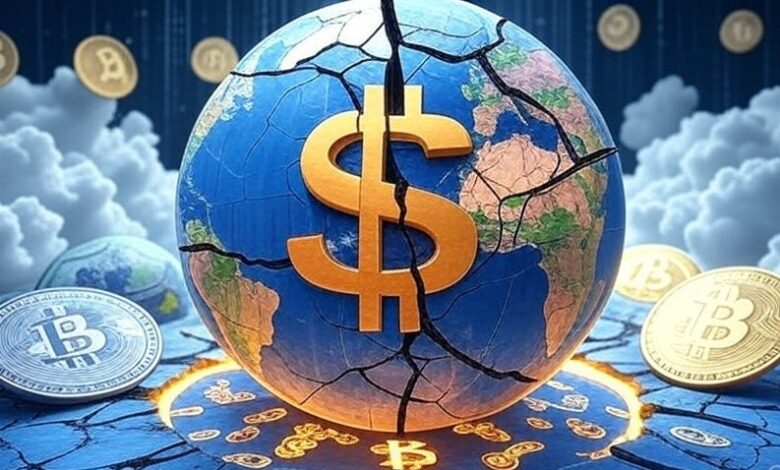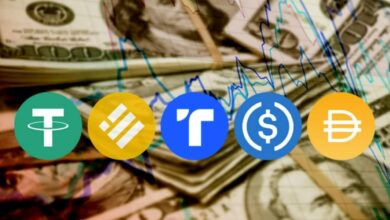The Dollar’s Digital Dilemma: How Stablecoins Are Rewiring the Monetary System

Market Unrest and the Bitcoin Question
The world feels tense. From escalating domestic unrest to rising geopolitical risks, uncertainty is everywhere. Naturally, in crypto circles and trader Telegrams, the same question returns: is this when Bitcoin finally proves itself?
Some believe yes. The dollar’s value is slipping and Bitcoin has often served as a hedge when confidence in fiat wanes. But others are less convinced. Bitcoin still trades like a risk asset, and the financial system isn’t so easy to disrupt.
Yet this time, it’s not inflation or war that could shift the balance. It’s stablecoins.
Stablecoins Are Quietly Taking Over
With Trump’s administration backing stablecoin regulation — and the GENIUS Act likely to pass — the U.S. dollar is entering a new phase. Stablecoins are no longer fringe financial tools; they’re becoming the backbone of how dollars move globally. Circle, Tether, and even traditional banks are now dollar distributors, buying massive amounts of U.S. Treasuries.
In fact, stablecoin issuers already rival China in Treasury holdings. Projections show they could manage more than $2 trillion by 2028.
This isn’t just financial innovation — it’s a redistribution of monetary power.
The Fed’s Grip Is Slipping
Officially, stablecoins are supposed to strengthen the dollar’s role globally. But central banks are uneasy. The Bank for International Settlements (BIS) warns that if stablecoin issuers rapidly sell off Treasuries — whether due to redemptions or market panic — yields could spike sharply, shaking global markets.
Every time a stablecoin is minted, the Fed’s control over interest rate policy gets slightly weaker. This is shaping up to be Greenspan Conundrum 2.0 — except now, the threat is coming from within the dollar’s own infrastructure.
As stablecoins take on more responsibility — moving dollars, buying Treasuries, serving as on-ramps for the global South — the U.S. government gains new reach. But the Fed loses autonomy. These are private firms with profit incentives, not policy mandates.
No Real Alternative on the Horizon
Despite dramatic headlines, no clear replacement for the dollar exists. Dedollarization and true decoupling remains premature. The European Union remains a major player in global trade, accounting for 14.4% of global imports and 15.8% of exports in 2024, according to Statista. However, despite its economic weight, the EU lacks the cohesion and muscle to challenge dollar dominance — even if the European Central Bank hints otherwise. Trump’s trade wars weren’t just about tariffs — they were about reinforcing U.S. financial control.
China? Still boxed in by capital controls, lack of convertibility, and a trust deficit with global markets.
As for BRICS? The idea of a shared currency has stalled. What looked like an emerging alternative is now more symbolic than practical — too many interests, too little trust, and no working system.
The UAE’s Digital Experiment
While the dollar dominates global finance, the UAE is quietly charting its own course in the digital currency space. The UAE is moving quickly to embrace stablecoins as part of its financial innovation. AE Coin, a stablecoin pegged to the UAE Dirham (AED), has received full regulatory approval from the Central Bank of the UAE (CBUAE), marking the launch of the first regulated stablecoin in the UAE.
However, UAE dirham remains pegged to the dollar, which limits the country’s monetary independence—even as it embraces crypto innovation. While, the approval of an AED stablecoin doesn’t break the peg, it opens a new layer of monetary sovereignty. It lets the UAE play in the stablecoin game without always routing value through the dollar. For an observer pointing to the constraints of the peg, this move could be seen as a first quiet crack in the wall — or at least a hedge against overdependence on USD-denominated instruments. The new stablecoin offers a digital payment and settlement layer within the UAE, reducing reliance on dollar-pegged stablecoins like USDT or USDC for regional transactions.
While the dollar remains dominant for now, the UAE’s digital experiments hint at subtle challenges to dollar supremacy in the future.
The Bitcoin Angle
So what happens to Bitcoin?
If the dollar weakens — not from hyperinflation, but from internal dislocation — Bitcoin could benefit by default. It won’t need to “decouple” from risk assets. It just needs to stay solvent while the U.S. experiments with digitizing its currency through third parties.
If stablecoins are the new face of the dollar, they may also be its weakest point.
Fault Lines Within the System
And what if U.S. unrest deepens? What if certain states start pushing rhetorical or legislative boundaries? Empires rarely fall from the outside. They crack when their own tools start working at cross purposes.
In trying to modernize the dollar, the U.S. may unintentionally dilute it. Stablecoins give the dollar reach — but they also introduce fragility.
Final Thought: Where Is the Real Risk?
So maybe the question isn’t whether Bitcoin is ready to replace the dollar.
Maybe it’s whether the dollar, in its new tokenized form, can hold itself together without weakening the very system it’s meant to empower.
The headlines will keep chasing inflation, elections, and war. But the deeper shift is already here — playing out in smart contracts, wallets, and Treasury flows.





